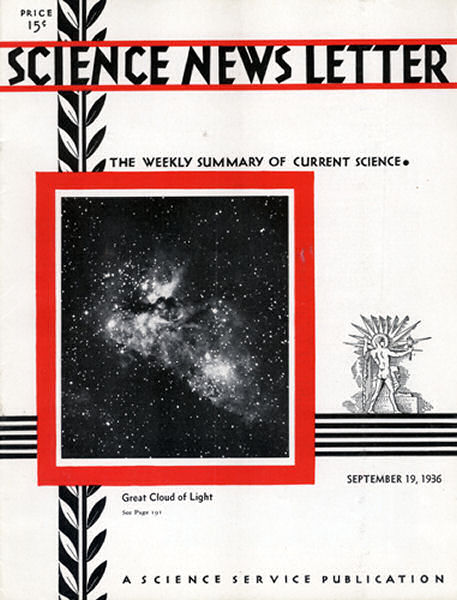From the September 19, 1936, issue

LARGEST GASEOUS NEBULA “FOUND” BY NEW TELESCOPE
The photograph of the great celestial cloud known to astronomers as the Eta Carinae nebula taken with the Harvard College Observatory’s new, 60-inch reflecting telescope at Bloemfontein, South Africa, is for scientific purposes practically a new discovery. This photograph appears on the front cover of this week’s Science News Letter.
Eta Carinae is the largest gaseous object in the sky that shines with its own rather than reflected light. Astronomers have known it for some time, but the powerful new telescope shows so many new details that the new photographs amount to an introduction.
This nebula is famous as the home of a great nova of many years ago, now gone back to its former middle-class astronomical obscurity. In this region also are many exceptionally hot stars.
OUNCE OF OIL COVERS EIGHT ACRES OF SURFACE
How films of oils can spread so thin that 1 ounce of oil can cover up to 8 and 9 acres of water surface was described at the meeting of the American Chemical Society by Prof. William D. Harkins and Dr. R.J. Myers of the University of Chicago.
Such thin films, which are often only one molecule thick—about one 20-millionth of an inch—have important uses in the lubrication of automobiles, the making of paint, the manufacture of laminated “safety glass” for windows, in color printing, and in biology and medicine.
A new finding of scientists, said Prof. Harkins, is that such thin films can also exist in a layer several molecules thick. Science has yet no adequate theory to explain the characteristics of such films.
The behavior of the films is, indeed, strange. With new apparatus, the University of Chicago chemists are now learning that the films can be in a “tight” condition wherein the molecules stand on end and side by side like the riders of a rush-hour subway car. Or they can also be in an “expanded” state where they seem to lie over more and take up more room.
Other types of oil molecules like to lie flat on the surface and thus cover more area. They, too, have the “tight” or “expanded” pattern.
An ounce of oil with the upright films will cover 3-and-one-half acres of water surface, said Dr. Harkins. The expanded films will occupy 8 acres of water surface. And if the “lying-down” molecules are considered, they will be found to cover from 15 to 20 acres of surface.
CANCER EXPLAINED AS UNCONTROLLED CELL GROWTH
Cancer was explained to the University of Wisconsin’s Cancer Institute as “the uncontrolled multiplication of permanently altered body cells which no longer need the special environment or special agent which originally induced them to grow.”
Dr. Warren H. Lewis, Carnegie Institution embryologist of Baltimore, Md., said that this finding is the result of research during which rat and mouse tumor cells were kept growing several years. The agent that induces normally behaving cells to “go wild” or become malignant may be a virus, a hormone, or a chemical substance, Dr. Lewis said. The cancerous cells grow true to their own particular type, and where they grow the normal cells soon disappear.
Thyroid gland added to the diet speeds and increases the growth of mouse tumors induced by coal-tar irritation, Dr. Leiv Kreyberg, Norwegian scientist, told the institute. He has been testing theories as to cancer growth by animal experimentation. Fish liver also increases rate of growth but does not influence the time of onset. Magnesium salts have no influence. Discouraging is his conclusion that well-nourished animals have more-vigorous cancer growths.
Heredity plays a large part in cancer, Dr. Madge Thurlow Macklin of the University of Western Ontario told the institute.







